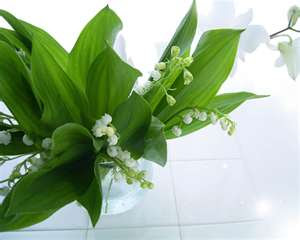If you are looking for an easy, perennial, flowering bulb to grow that will give you years of satisfaction, try growing lily-of-the-valley. The sweet, intoxicating, bell-shaped blooms seem to herald the arrival of spring. Lily-of-the-valley is also known as Convallaria and is a must addition for gardeners looking for flowering plants to add to the shady regions of their landscape. Not only is lily-of-the-valley easy to grow, it is also quite hardy once established.
Step 1
Soak your lily-of-the-valley bulbs, or pips, in a plastic bowl of lukewarm water. Allow the pips to stay in the water for several hours. They will begin to swell from absorbing water, and this will help them start growing quicker once planted.
Step 2
Select an area in your garden that is either situated in full shade or partial shade. It is best to not plant the lily-of-the-valley pips in a location that receives full sun as they will not do well.
Step 3
Amend the soil with organic matter such as peat, manure, compost or pine bark to make it richer. You also need soil that drains well as the pips will not do well planted in an area that floods. The pips will rot and die before they even start growing.
Step 4
Snip off one inch from the end of the roots on the pips before planting. This will help moisture get into the roots and make them start growing quicker.
Step 5
Plant your lily-of-the-valley pips in a hole just deep enough to where the top of the pip is sticking out of the ground. Space each pip approximately 1 ½-inch apart. Pack the soil down firmly around each pip.
Step 6
Water the newly planted pips well. Keep the soil where the pips are growing moist, but not soggy.
Step 7
Prune off the flower stalks as they begin to bloom. Once the plant has stopped blooming, do not cut off the foliage for winter. Allow the foliage to remain for the plant to continue getting nutrients.
Step 8
Fertilize the lily-of-the-valley plants twice per year with a high quality general purpose 10-10-10 fertilizer. Fertilize once in late spring and then again in summer.
Step 9
Lay mulch around the base of the plants during the winter to protect the root system.


No comments:
Post a Comment